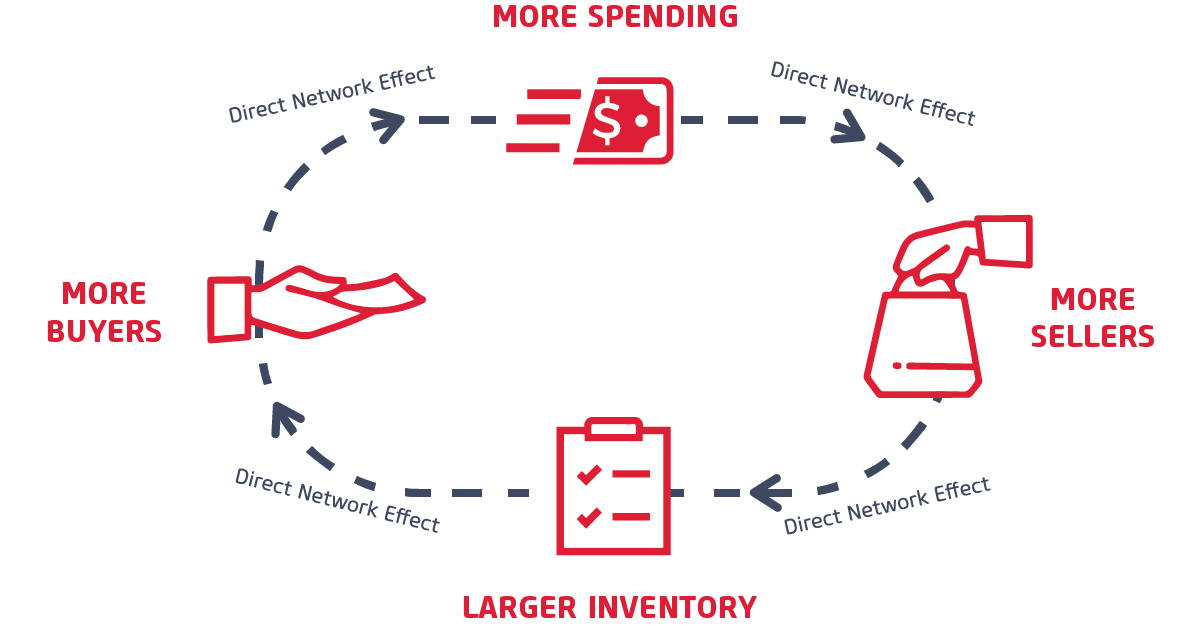Over a decade after the launch of both Airbnb in August 2008 and Uber in March 2009, the platform business model continues to be a growing trend.
Many new startups, like Instacart, adopt a platform business model as part of the core of their strategy. Other traditional companies have adopted them like Walmart, who have evolved its linear business models to include platform capabilities in solutions like Walmart Marketplace. They are used by seven of the world’s top ten most valuable companies Alibaba, Alphabet (i.e. Google), Amazon, Apple, Facebook, Microsoft and Tencent (as per 2018 Top Ten Most Valuable Companies list).
But it is not easy to create a successful platform company:
- Uber, the darling of ride-hailing, has yet to make a profit; lost $8.5 billion in 2019.
- Spotify for the first time made a profit in 2019.
- Airbnb has been intermittently profitable in the past but lost $270 million in 2019.
What Makes the Platform Business Model Successful?
To make a platform business model successful requires the application of network effect and zero marginal cost. These two critical components open up the opportunity to create affordable, high growth platform businesses in previously overlooked market needs.
Network Effects
Medium, the online publishing platform, is an example of the power of network effects in social journalism. Through its double-sided network, it has grown an extensive collection of amateur bloggers and professional journalists, along with 10’s of millions of content followers.
Network effect occurs when the value delivered to each user in one group increases as the number of users in another interdependent user group grows. The more people that use it—attracts still more users. For example, in a B2B product marketplace, the more suppliers on the platform, the more buyers will be attracted to join and visa-versa. Networks greater size brings more value, more efficiency and greater convenience for users

Zero Marginal Cost
Network effects are only part of the reason why platform business models are dominant today.
One of the other compelling aspects of a platform business model is its ability to scale without increasing costs. To see that, you need to look at the costs and profit structure that underlie platform business models. Marginal cost is the cost incurred by producing one additional unit of a product or service. The cost to serve another platform user is zero, mainly due to the application of the internet, connected technology and the application of data. With network effects, the value it delivers continues to grow as more users join it while the marginal cost of the digital goods tends to zero.

Additional Benefits of a Platform Business Model
Network effects and zero marginal costs are not the only platform business model characteristics that make it disruptive to linear businesses:
- The platform does not own product/service production directly.
- Few internal resources or assets, especially compared to a linear business.
- Enables value creation by facilitating connections and transactions.
- Require less capital expenditure and fewer internal resources to scale once their network is established compared to a linear business.
- Platforms dominate markets, not by acquiring more assets and resources. Instead, it is the value they create by connecting users.
Creating a successful platform business is not straight forward.
So why isn’t everyone building a platform? The risk for platform businesses is substantial due to the lack of direct control over inventory, and they don’t own its most valuable asset, its users.
To reap the platform business model’s benefits, you need to attain a critical mass of buyers and suppliers. One of the reasons Uber has not been profitable to date is it continues to invest in new cities to develop an extensive network of drivers to attract riders and to make it difficult for competitors to enter the market. Amazon did not make a profit for years because it invested in warehousing and logistics to ensure it could attract customers through quality service.
Like most initiatives, there are risks if doing things too quickly and not establishing the required business processes and controls. By developing the business too fast and too early to the market, issues may arise that you may not be able to fine-tune quickly enough before doing severe damage. Adopt a lean – build, measure, and learn iterative approach to ensure you roll out the business in a controlled manner.
As described in the book Modern Monopolies by Alex Moazed and Nicholas L. Johnson, you must attract users on both sides to join in a controlled manner, and provide the tools to help match them together. You must provide secure and integrated technology to facilitate the transaction, and you must establish the rules that govern the network to build trust and maintain quality. You must limit the number of disruptive users.
Are Platform Businesses Invincible?
Time for a reality check:
1. Many of the platforms discussed in this post are purely digital. They do not have unique resources or capabilities that are difficult to copy; also,
2. Depending on the platform type, the capital startup and operational costs are relatively low; and,
3. Lyft and Uber are engaged in fierce competition and spending vast amounts of venture capital to reach scale.The scale will not provide a competitive advantage if your customers can all leave for another digital platform tomorrow.
In today’s digital world, technology and innovation have created new products and facilitated the creation of new business models that have disrupted long-standing traditional businesses. It is unclear what inventions are around the corner that bring new concepts that could vapourize the platform business model.
Wrap up
The world of platform business is dynamic, full of advantages - and full of challenges. If you are considering expanding into new markets with a platform or considering joining an existing platform business, we would be happy to hear from you to help plan a strategic path for the future. Success is possible!
Related Resources:
This is the third in a three-part series focused on innovation:
 Innovation Growth Strategy- Part 1 of a 3-Part Series
Innovation Growth Strategy- Part 1 of a 3-Part Series
 Product Innovation Part 2: JBTD & ODI
Product Innovation Part 2: JBTD & ODI





Submit a Comment